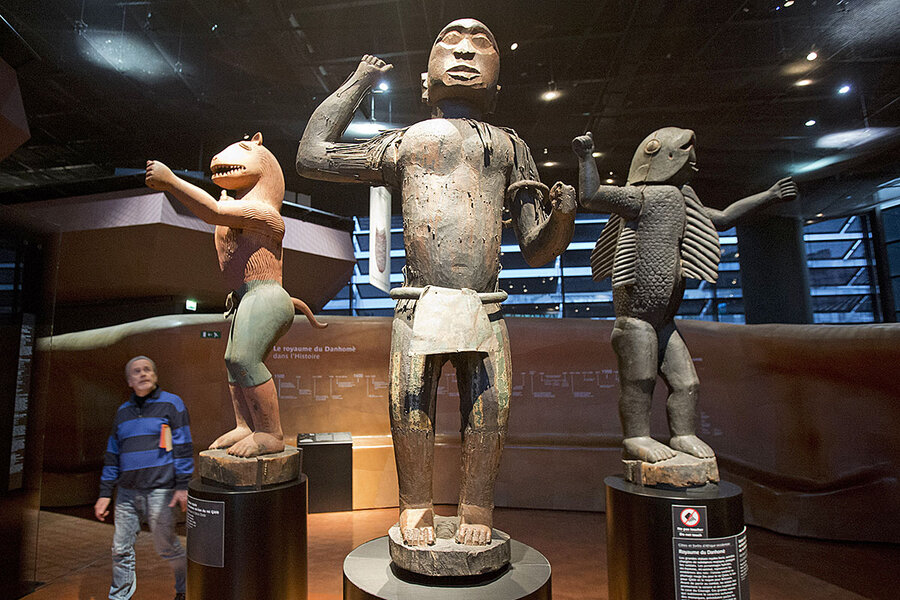Art lessons: Why France is giving countries back their cultural treasures
Loading...
| Paris
Nearly half a million items, an estimated 90 percent of sub-Saharan Africa’s cultural heritage, are held – mostly in museum cellars – outside the continent. A debate over what to do with all of these artifacts has been gathering pace in recent years, as former colonial powers reconsider their history. French President Emmanuel Macron has broken with decades of tradition and ordered the immediate return of ancient royal items to Benin and challenged museums to give back items taken without countries’ consent. The global rise of identity politics and nationalism has fed the argument, says Tom Flynn, an art historian. On one side, he sees “those who make a cultural, national claim to items that are part of their deep identity,” such as tribal masks in Nigeria or the marble sculptures taken from the Parthenon in Athens, now on show in the British Museum. On the other side are major national museums whose collections “are bound up with national identity,” Mr. Flynn says. “To diminish them” by returning items “is seen as diminishing the national past.” Mr. Macron has taken a different approach, breaking with decades of traditional policy. “African cultural heritage can no longer remain a prisoner of European museums,” he tweeted.
Why We Wrote This
“It belongs in a museum,” as Indiana Jones once said of an artifact. But which museum? From Easter Island to Greece, countries are asking for their cultural treasures back – and, in a sign the tide may be shifting, a leader of a colonial power has said yes.
In the face of a swelling chorus of demands from Africa and elsewhere, French President Emmanuel Macron has challenged museums around the world to return cultural treasures to the places from which they were taken without consent in colonial times.
Last Friday he lent his backing to an expert report calling for the repatriation of such African artifacts from French collections, and ordered the immediate return of 26 ancient royal items that Benin has requested. His move has shaken up an international debate about what museums should do today with items acquired in dubious circumstances more than 100 years ago – even as some high-profile repatriations by institutions such as New York’s Metropolitan Museum of Art indicate slowly shifting thinking on the matter.
“A national leader like Macron breaking new ground gives new impetus” to campaigns being waged by peoples around the world for the restitution of their cultural heritage, says Tristram Besterman, a former head of the UK Museums Association Ethics Committee.
Why We Wrote This
“It belongs in a museum,” as Indiana Jones once said of an artifact. But which museum? From Easter Island to Greece, countries are asking for their cultural treasures back – and, in a sign the tide may be shifting, a leader of a colonial power has said yes.
Last week the governor of Easter Island visited London to ask the British Museum to return one of the Pacific island’s totemic statues, plundered in 1868 by a British naval vessel. “We are just the body. You, the England people, have our soul,” said Tarita Alarcón Rapu, fighting back tears.
Museum authorities made no offer to return, or loan, the statue.
Nearly half a million items, an estimated 90 percent of sub-Saharan Africa’s cultural heritage, are currently held – mostly in museum cellars – outside the continent. A debate over what to do with all of these artifacts has been gathering pace in recent years, as former colonial powers reconsider their history.
“I belong to a generation of French people for whom the crimes of European colonization are incontestable,” Mr. Macron told an audience of students in Burkina Faso last year.
At the same time, the global rise of identity politics and nationalism has fed the argument, says Tom Flynn, an art historian who writes on cultural heritage issues. On one side, he sees “those who make a cultural, national claim to items that are part of their deep identity,” such as tribal masks in Nigeria or the marble sculptures taken from the Parthenon in Athens, now on show in the British Museum.
On the other side are major national museums whose collections “are bound up with national identity,” Mr. Flynn says. “To diminish them” by returning items “is seen as diminishing the national past.”
In Britain, where 40 percent of citizens are proud of Britain’s colonial history, according to a 2016 YouGov poll, that argument carries weight.
Macron has taken a different approach, breaking with decades of traditional policy. In his Burkina Faso speech, he declared that he wanted “to see the conditions put in place so as to allow for the temporary or definitive restitution of African cultural heritage to Africa.”
“African cultural heritage can no longer remain a prisoner of European museums,” he tweeted.
The two experts he commissioned to report on the issue presented their conclusions on Friday. They called for the “restitution in a swift and thorough manner ... of any objects taken by force or presumed to be acquired through inequitable conditions” from Africa.
Macron clearly hopes other former colonial powers will take note. “The idea is to encourage other countries to explore how they might contribute to this dynamic,” says presidential spokeswoman Selen Daver. Macron announced he will convene a conference of European and African countries early next year “to build a new relationship and policy of exchange together.”
Items have been returned in the past: Italy handed back an obelisk taken from Ethiopia in the 1930s, and France returned to South Korea 300 manuscripts stolen from a royal library by marauding French troops in 1866, for example.
But often such restitutions have occurred only after “painful struggles,” the new French report points out. And in many museums, officials are still deeply reluctant to accept the arguments of source communities, for fear of losing star items from their display cases.
Even the British law allowing the return of Nazi-looted artworks to their owners’ descendants “passed only in the teeth of opposition from the national museums,” recalls Mr. Besterman.
“One of the prerequisites of being named director of a big UK museum is that you won’t start giving things back,” says Flynn.
Recently, though, there have been signs of movement, however hesitant. “The debate about how to treat this important aspect of the colonial heritage is as challenging as it is overdue,” said Hartmut Dorgerloh, head of the Humboldt Forum in Berlin, responding to the French report.
“Looted art must always be returned,” he added.
The United States has returned more than 8,000 stolen artifacts – from paintings to fossils – to 30 countries since 2007, according to data from US Immigration and Customs Enforcement. One high-profile example of repatriation came in 2017, when the Hobby Lobby chain store returned 5,500 illegally smuggled artifacts, including ancient cuneiform clay tablets, to Iraq.
At the Royal Museum for Central Africa outside Brussels, due to reopen next month, director Guido Gryseels, who has in his care hundreds of thousands of items stolen from the Belgian Congo, acknowledged in a recent interview with Le Monde newspaper that “Africa is a continent that was pillaged, emptied. We cannot ignore this subject and we have to find solutions.”
Among the solutions that the French government is promoting as well as outright restitution, which will require changes to French law, are traveling exhibitions, exchanges, and loans.
Earlier this year the director of the Victoria and Albert Museum in London raised the prospect of a long-term loan to Ethiopia of royal treasures looted by British soldiers from Maqdala, an Abyssinian imperial stronghold, in 1868, though nothing has yet come of that idea.
And last month, major European museums agreed to lend contested artifacts, including some famous bronzes, to a new museum in Nigeria that they will help to build.
But loans, however extended, do not fulfill the deeper needs of the communities who want their cultural artifacts back so that they can tell their own historical stories in their own way, says Besterman, the former museum ethicist.
“What you are really talking about is repatriating authority and dignity and the ability of a source community to make its voice heard,” he says. “For too long, big museums have had their fingers in their ears.”
But that cannot last, predicts Mnyaka Susuru Mboro, a Berlin-based activist from Tanzania. Around Europe, he says, museums “are just waiting to see where France is headed, whether they start giving things back.
“They’ll have to react,” he says. “They’ll have to take some action.”








